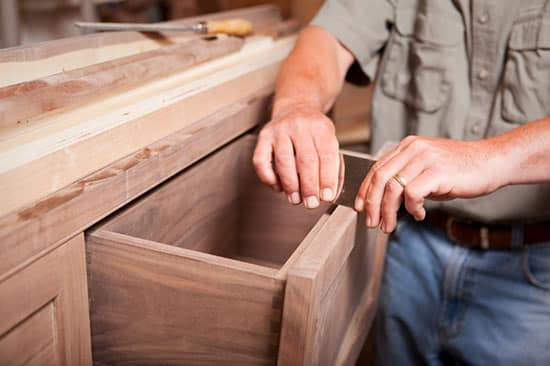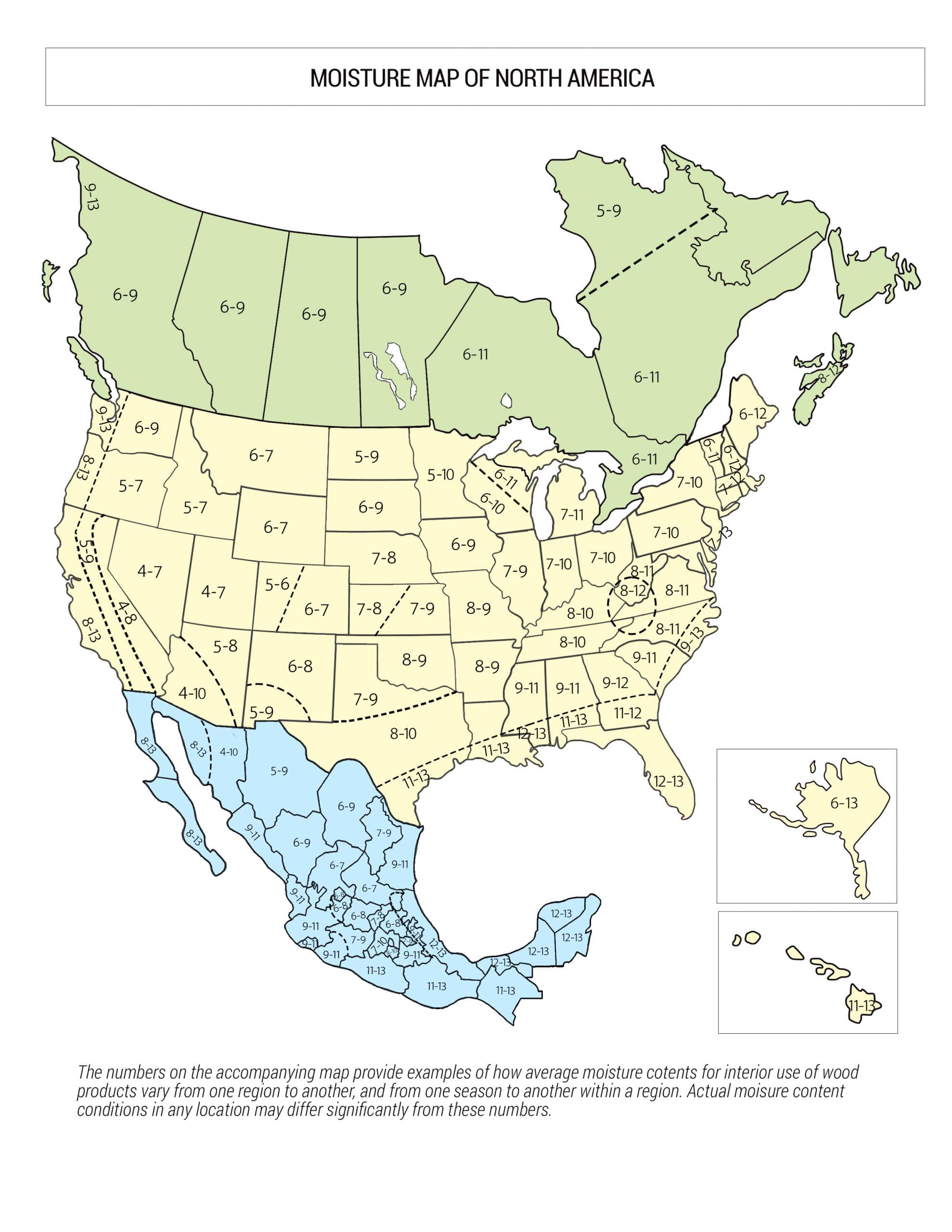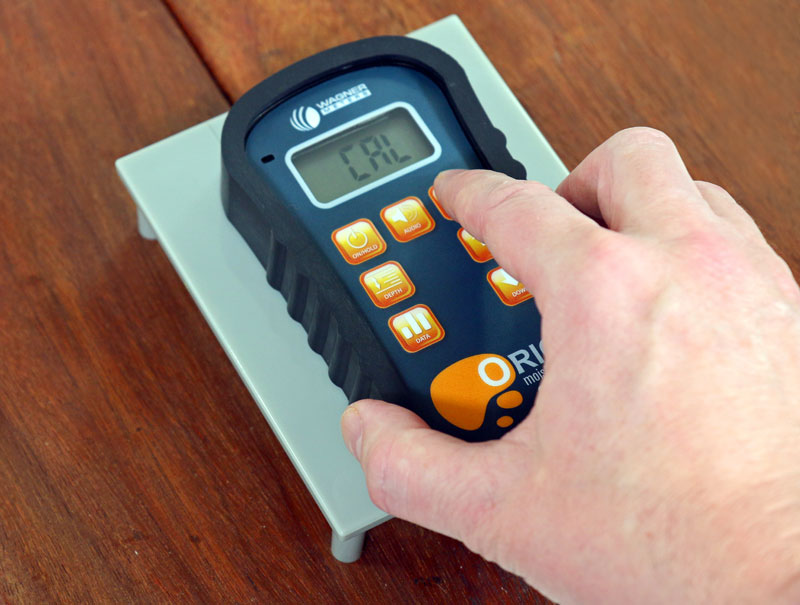Wood Moisture Meters for Cabinet Makers
As a cabinet maker, precision and craftsmanship define your work. You take pride in every joint, every panel, and every finish—ensuring your cabinets are both functional and beautiful. But what happens when gaps appear, doors swell shut, or finishes peel away?
Often, the root cause is moisture imbalance in the wood.

The key to prevent moisture damage to your cabinetry projects is to pay close attention to the moisture content of the wood.
Wood is hygroscopic, meaning it naturally absorbs and releases moisture based on its environment. If the moisture content (MC) isn’t properly managed before assembly, your cabinets could warp, crack, or delaminate—leading to costly repairs, frustrated clients, and damage to your reputation.
The solution? A high-quality wood moisture meter.
By using a pinless moisture meter, you can quickly and accurately measure MC without damaging your materials. This simple step ensures your wood has reached equilibrium moisture content (EMC) before construction—eliminating guesswork and preventing failures down the road.
In this guide, we’ll cover:
✔️ Why moisture content matters for cabinet making
✔️ The ideal moisture levels for cabinetry
✔️ How a wood moisture meter enhances accuracy and efficiency
✔️ Why Wagner’s pinless meters are the trusted choice for professionals
Whether you’re crafting kitchen cabinets, custom built-ins, or furniture-grade pieces, moisture control is the key to long-lasting results. Let’s dive
Table of Contents
- Why moisture content matters for cabinet making
- Acceptable moisture levels for cabinets
- How a wood moisture meter can make a difference in your work
- Why you can trust a moisture meter
Why Does Moisture Content Matter for Cabinet Making?

With a pinless wood moisture meter, you’ll obtain information that will help you be more successful and efficient in your work and protect your reputation.
Understanding moisture content is key to preventing moisture damage to your cabinetry projects.
See, wood is a hygroscopic material, meaning that it naturally absorbs and releases moisture until it reaches the moisture content (MC) of its environment, known as the equilibrium moisture content (EMC for short).
If a cabinet has an MC much higher than the EMC, it’ll release moisture to reach the EMC. As it releases moisture, it may shrink or crack. You might notice gaps and openings between cabinet doors and their joints.
On the other hand, a cabinet with too low of an MC compared to the EMC will start to gain moisture and swell. It may swell so much that the doors won’t be able to shut.
Or, if you’re using particle board or medium-density fiberboard for parts of the cabinet, the layers of these wood materials can start to swell or separate from one another—known as delamination.
Excess moisture can also cause paint to peel or damage other kinds of finishes.
Ultimately, moisture damage affects the appearance, strength, and stability of cabinets and is much better avoided.
But the issue isn’t moisture on its own—it’s excess moisture. After all, wood still retains some level of moisture. And as we’ve already discussed, that has a lot to do with the surrounding environment.
Several factors impact wood moisture content. They are:
- Humidity
- Temperature
- Seasonal changes
- Wood species
- Type of cut
Let’s look at each one.
Humidity
Humidity is a measure of the amount of moisture the air can hold. Higher humidity will cause wood to absorb more moisture. Generally, an indoor relative humidity between 30% and 50% is recommended for keeping wood pieces stable.
Temperature
The temperature of the air influences how much moisture the air can hold (humidity). Typically, cabinets need a stable temperature somewhere between 40° and 90° F.
Seasonal Changes
As seasons change, humidity and temperature levels fluctuate.
For example, if you live in Virginia, you’ll experience humid summers but dry winters.
To keep cabinets from warping or changing with these fluctuations, use humidifiers or dehumidifiers as necessary to maintain a consistent indoor climate.
Wood Species
Different species of wood may take longer to lose or gain moisture, usually because of their differences in density or structure.
Type of Cut
How a piece of wood has been cut will affect how fast the wood loses or gains moisture. The reason for this is that wood can lose moisture from three different dimensions:
- Tangentially
- Radially
- Longitudinally
But the wood tends to lose more from certain dimensions than others—a concept known as dimensional shrinkage. Typically, most shrinkage occurs tangentially and radially with very little shrinkage longitudinally.1
Thus, quartersawn wood, cut at an angle of 70 to 90 degrees, is much more stable than flatsawn wood, cut at an angle of 0 to 45 degrees.2
As you prepare your materials for cabinets and measure their moisture content, keep these factors on your radar.
What Are Acceptable Moisture Levels for Cabinets?
 For cabinets, the ideal moisture content for wood is typically between 6 and 8%.3 This range is standard for wood pieces that will be indoors.
For cabinets, the ideal moisture content for wood is typically between 6 and 8%.3 This range is standard for wood pieces that will be indoors.
But the exact number will vary depending on your region and climate. You can find the EMC for your area using an EMC chart.
For example, the EMC in a dry, arid location like Utah will be much different than in a humid state like Florida. The number will likely still be in the 6 and 8% range, but it may be on the higher or lower end, depending on where you are.
How Will a Wood Moisture Meter Make a Difference in Your Work?
A wood moisture meter is essential for preventing failure and ensuring success in the long run. It will also make you a more efficient cabinet maker, saving you time and money, and protecting your reputation.
With a moisture meter, you can make sure the MC of your wood is at the EMC of its final location before you begin building. If you detect that the wood is too wet or too dry, you’ll be able to allow it to acclimate before you begin.
Failing to do so, you run the risk of using wood with an improper moisture content—and dealing with all the issues we’ve mentioned throughout this article:
- Warping
- Movement of parts
- Gaps
- Bad finishes
- Peeling paint
- Delamination
Knowing the wood’s MC and checking that it’s reached the EMC will help prevent costly mistakes. You’ll maintain the quality and longevity of the finished product, and satisfied customers will no doubt boost your reputation.
But you may wonder, Can I trust a wood moisture meter to do all that?
Can You Trust a Wood Moisture Meter?

You can trust your moisture meter if you use a high-quality meter and make sure it is properly calibrated for accurate readings.
The short answer is yes, but it depends on the type of wood moisture meter you’re using. To ensure that you’re getting accurate readings, use a high-quality moisture meter, make sure it’s properly calibrated, and follow the manufacturers’ instructions carefully.
The wood moisture meters at Wagner Meters use pinless technology so you don’t have to worry about poking holes into your cabinets.
And third-party studies have found that our pinless meter technology is more accurate than the studied pin-type meters. That means they’re both non-destructive and trustworthy!
For added assurance, our Orion® meters have an on-demand calibrator that allows you to check the calibration of your meter and calibrate it if necessary. Simply place the meter on the calibration block per the instructions, and within minutes, your meter will be set to go!
You’ll know the MC of your wood and be on your way to building cabinets that stand the test of time.
Don’t let moisture damage ruin your hard work. Ensure the longevity of your cabinets with our accurate and non-destructive Orion Pinless Moisture Meters. Shop Wagner Meters now and build cabinets that stand the test of time!
- “Dimensional Shrinkage,” The Wood Database.
- Wengert, Gene, “Quartersawn vs. Flatsawn,” Woodworking Network, May 31, 2014.
- Cassens, Daniel, “Controlling Moisture Content in Stored Lumber,” Purdue University Forestry and Natural Resources.

Jason Wright, Business Development Specialist for New Products, joined Wagner Meters in 2019. He comes to Wagner with over 35 years of experience in the flooring industry.
Last updated on March 17th, 2025



